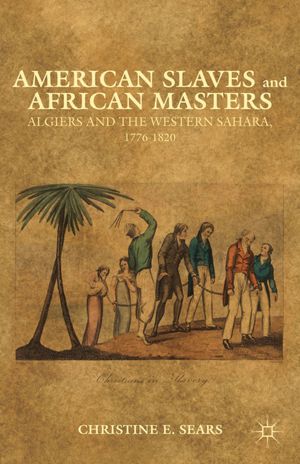
Dr. Christine Sears is an associate professor of history at UAH and the author of American Slaves and African Masters.
High-seas misadventure, pirates, ransoms! Those may sound like the plot points of Tom Hank's latest blockbuster movie "Captain Phillips." But according to American Slaves and African Masters: Algiers and the Western Sahara, 1776-1820, American sailors have faced peril at the hands of Africans who sought to capture them since the nation's earliest days.
"Sailing was one of the better paid jobs at the time, but it was really dangerous," says author Dr. Christine Sears, associate professor of history at The University of Alabama in Huntsville. "One sailor, John Foss, was captured in 1793 and released in 1796, only to have his ship pulled over by privateers another five times before making it home!"
In fact, some estimates suggest that more than one million Europeans were captured and enslaved in Africa between the 15th and 19th centuries. But Dr. Sears chose to focus her book, which is based on her Ph.D. dissertation, on the Americans who were taken as slaves between 1776 and 1820.
"Sailors were a fairly literate group and could read and write," she says. "So in the library I found these narratives of sailors who were captured by Algerian pirates or who were caught in the current, shipwrecked, and captured on the shores of Western Sahara on their way to get salt or even illegally pick up slaves."
Once captured, she continues, they faced very different experiences. In Western Sahara, the American sailors mostly focused on "just staying alive in the desert," living day to day much like their own captors. But in Algiers, they enjoyed a much more tolerable lifestyle, residing within the city's walls in slave neighborhoods known as bagnios.
Most of us think slavery was like the 19th century antebellum system in the United States, but that model is actually an outlier.
"In Algiers there was an older system of slavery in which the slaves could buy privileges," she says. They could also work on public projects, receive an allowance, and roam the city by day as long as they returned home at night - all factors that may account for why Dr. Sears says she found very little evidence of slave rebellions.
But no matter where the sailors were, it goes without saying that life as a slave was still nothing short of unenviable. "Plague was recurring in Algiers in those days, and in the bagnios the plague would spread," she says. The desert, meanwhile, posed graver dangers. "Even their masters had trouble living there!" say Dr. Sears.
So it's no surprise that some Americans died during captivity. What is a surprise, however, is that more - in fact, most - did not. "Over time the Americans were fairly lucky at getting out," she says, attributing the safe return of the majority of the sailors to a well-established system of ransom.
"It was a more formal arrangement - that's how they did business," she says, adding that captains were especially valuable and tended to be released sooner. "The sailors who were captured could get bailed out by the government as part of a treaty agreement, or sometimes the ambassador or their families would front the money."
That, of course, is a stark contrast to the system that characterized slavery in the U.S., a discovery Dr. Sears made while researching her book. "Most of us think slavery was like the 19th century antebellum system in the United States, but that model is actually an outlier," she says. "More slavery than not was like the West African system."

The cover image is from a rare book dating back to the 1820s.
And the West African system, she continues, was based on the even earlier, centuries-old Roman or Ottoman-Mediterranean system in which slaves tended to result from war or debt. "If you look at the ancient world," she says, "slavery was usually temporary and not passed on to the kids."
It also didn't inspire the kind of intense resistance - abolitionism - that ultimately led to the downfall of slavery in America. "I have to admit I thought the American sailors would come out of the experience and be against slavery, but they all seem to have taken it in stride," says Dr. Sears, who adds that only one went on to become an abolitionist.
It was for these reasons that Dr. Sears originally wanted to title her book A Different Kind of Slavery, a nod to the less well known but more prevalent Ottoman-Mediterranean system. But given how deeply entrenched the plantation model is in the American psyche, she was worried people wouldn't know what she meant.
Still, she hopes American Slaves and African Masters will go some way toward correcting the confusion. "You have to look at the context - where it is, when it is, who's involved, and what are they doing," she says when it comes to understanding slavery.
And that's an approach that she herself now relies on as she begins her second book, an examination of American sailors who were impressed into service by the British navy. "I am looking at nationality and how the sailors at the time thought about nationality," she says of the companion piece.
In the meantime, anyone who might be interested in learning more about the thrilling world of piracy may want to do the old fashioned way: skip a night at the theater and curl up with a copy of Dr. Sears' real-life, high-seas read.